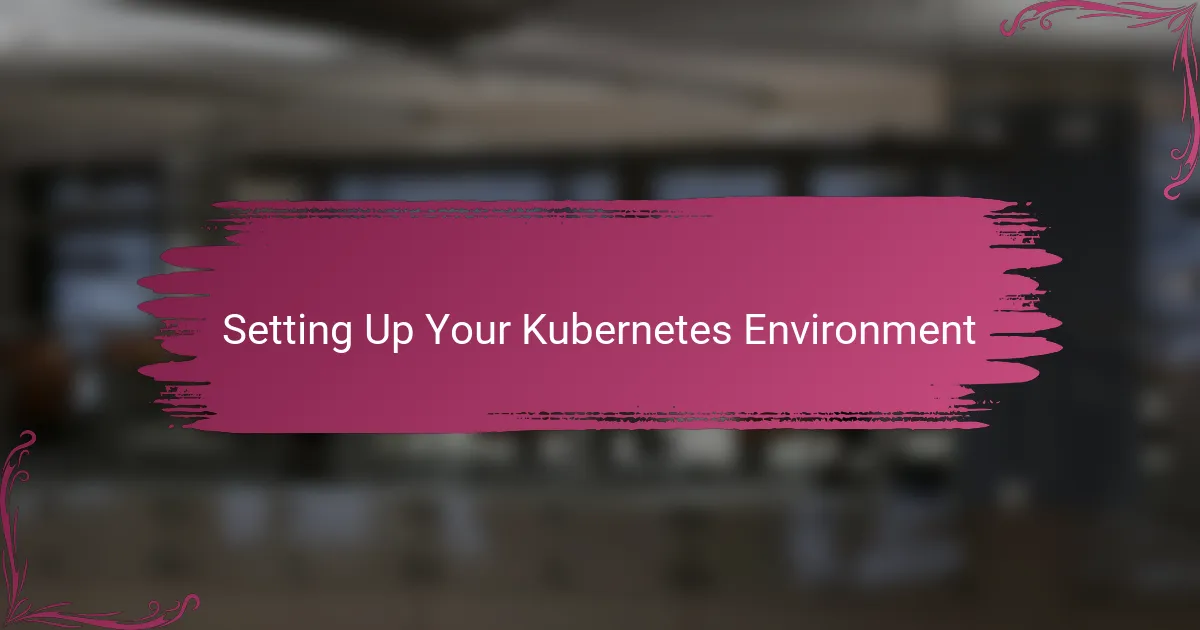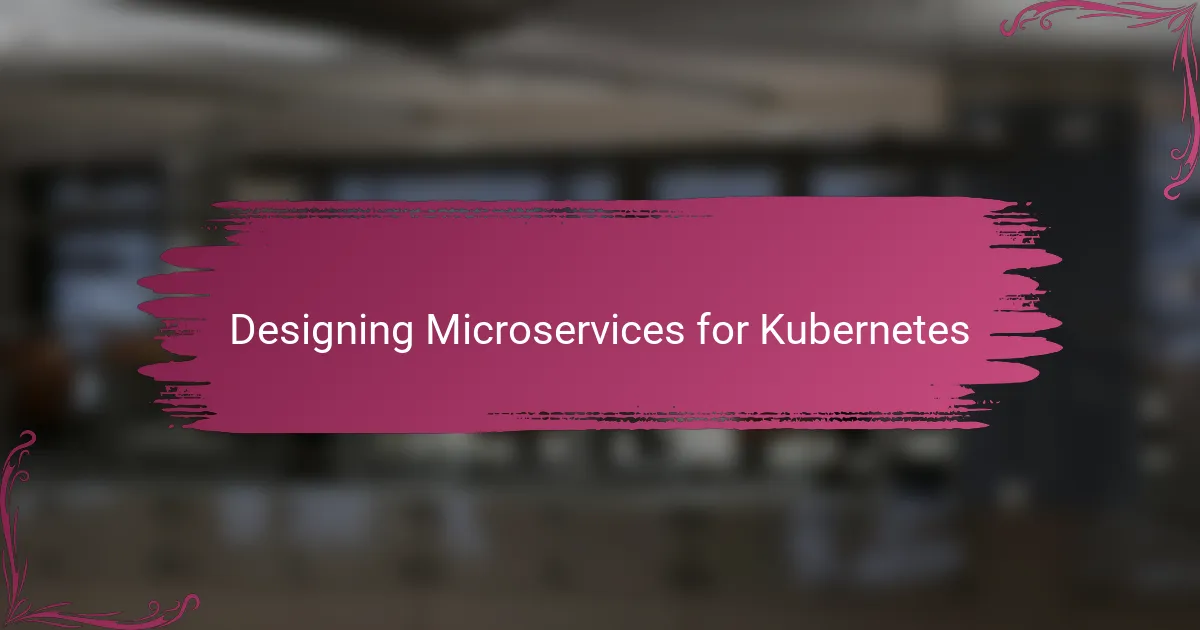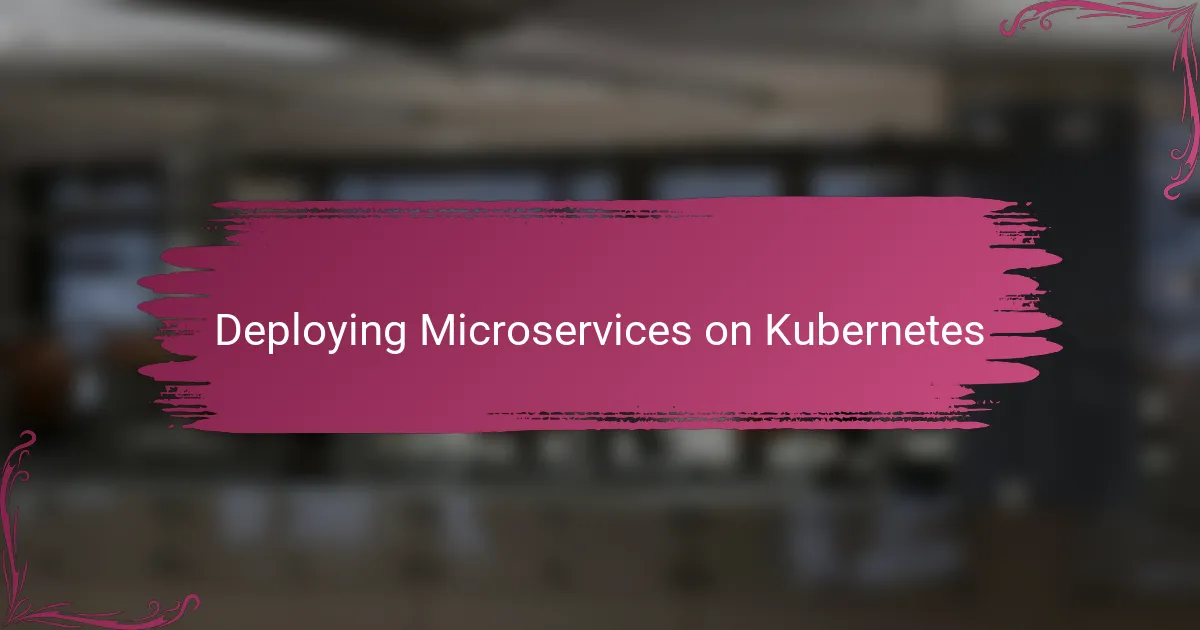Key takeaways
- Microservices architecture allows for scalable and flexible application development by breaking down applications into independent services, each managing a specific business function.
- Kubernetes simplifies container management and enhances reliability by automating scaling, deployment, and recovery processes.
- Designing microservices effectively requires clear boundaries, stateless architecture, and well-defined APIs to ensure smooth communication and prevent chaotic dependencies.
- Effective management of microservices in Kubernetes involves using autoscaling, rolling updates, and monitoring tools to maintain stability and performance during traffic shifts and deployments.

Understanding Microservices Architecture
When I first encountered microservices architecture, it felt like stepping into a vastly different world from the traditional monolithic approach. Instead of building one large application, you break it down into smaller, independent services—each handling a specific business function. This separation can be surprisingly empowering, but it comes with its own set of challenges.
Have you ever wondered how fragmented pieces can somehow work seamlessly together? For me, understanding that each microservice communicates through lightweight protocols like HTTP or messaging queues was a key insight. It’s like assembling a puzzle where each piece has its own intelligence, yet needs to align perfectly with others to form the bigger picture.
What truly fascinated me was the idea of scalability and flexibility. With microservices, you can upgrade or fix one component without disrupting the entire system, which was a game-changer in my development experience. It’s not just about code structure—it’s about changing how you think about the entire lifecycle of your applications.

Introduction to Kubernetes Basics
Diving into Kubernetes for the first time reminded me of learning a new language—initially overwhelming but incredibly rewarding once the basics clicked. At its core, Kubernetes is a platform that helps you manage containers, which are like lightweight boxes packaging your microservices and all their dependencies. It felt like discovering the ultimate organizer for my code’s chaos.
One thing that stood out immediately was the concept of pods. Think of pods as the smallest deployable units in Kubernetes; they group one or more containers that need to work closely together. Realizing this helped me see how Kubernetes treats applications not as single entities but as flexible teams collaborating under the hood.
Have you ever struggled with keeping your applications running smoothly during updates or sudden traffic spikes? Kubernetes handles these challenges naturally by orchestrating your containers—automatically scaling them up or down and recovering from failures. That reliability gave me the confidence to embrace microservices with less fear of downtime or manual babysitting.

Setting Up Your Kubernetes Environment
Getting my Kubernetes environment set up felt like laying a solid foundation before building a complex structure. I started by choosing the right cluster—whether it was a local setup with Minikube for quick experiments or a cloud-based service like GKE for real-world deployments. This decision impacted everything that followed, so I took my time evaluating options.
Next, I configured the kubectl command-line tool, which became my go-to interface for interacting with the cluster. Initially, running those commands felt a bit like speaking a foreign dialect, but once I got the hang of context switching and namespaces, it became a powerful ally. Have you ever felt that rush when your first pod spins up without errors? That moment always made me appreciate the setup effort.
Finally, I made sure to manage access controls and permissions carefully, setting up role-based access control (RBAC) to avoid any surprises down the road. It wasn’t just about security—it was about peace of mind knowing my environment was resilient and ready for the complex orchestration microservices demand. This preparation saved me from headaches later and kept my deployments smooth.

Designing Microservices for Kubernetes
Designing microservices for Kubernetes felt like crafting a well-orchestrated symphony, where each service plays its part independently but harmonizes perfectly with others. I quickly realized that defining clear boundaries for each service wasn’t just a best practice—it was essential to avoid tangled dependencies that could spiral into deployment nightmares. Have you ever tried untangling spaghetti code? Designing microservices thoughtfully prevented that chaos for me.
Another thing I learned was the importance of building microservices to be stateless whenever possible. It was somewhat challenging at first, but making services stateless meant Kubernetes could freely scale them up or down without worrying about losing critical data. This design mindset was a game-changer in how I approached service resilience and availability.
I also made sure each microservice exposed well-defined APIs and used lightweight communication protocols like REST or gRPC. It felt like setting up clear, polite channels for my services to “talk” to each other without stepping on toes—a crucial step that saved me from many debugging headaches later on. Have you ever wondered how tiny, independent parts keep a larger system running smoothly? Clear communication is the secret sauce.

Deploying Microservices on Kubernetes
Deploying microservices on Kubernetes was as much about mindset as it was about technology. I found myself shifting from thinking of deployments as monolithic updates to managing numerous small services independently. This granular control felt liberating but also introduced new complexities, like orchestrating the timing and configuration of each microservice to ensure seamless interaction.
One moment that stuck with me was when I first applied Kubernetes manifests using kubectl and watched each microservice spin up in its own pod. It was like seeing a well-rehearsed cast take the stage one by one, each ready to perform its role without stepping on others’ toes. Have you ever experienced that mix of excitement and nervousness when seeing your architecture come alive? That’s what deployment felt like for me.
I also quickly learned the power of Kubernetes’ features like Deployments and Services to manage updates and traffic routing. Rolling updates became almost effortless, and load balancing happened transparently behind the scenes. It’s incredible how Kubernetes can take so much operational burden off your shoulders, letting you focus more on improving the microservices themselves rather than babysitting deployments.

Managing and Scaling Microservices
Managing and scaling microservices brought a whole new layer of complexity that initially felt daunting. I remember the first time I saw a sudden spike in traffic and wondered if my setup could handle it. Thankfully, Kubernetes’ autoscaling capabilities took over, dynamically adjusting the number of pod replicas to match demand, which was a huge relief.
One thing I learned through experience is that managing microservices isn’t just about scaling up; it’s also about maintaining stability as components evolve. Kubernetes’ rolling updates allowed me to deploy new versions without any downtime, which kept users happy and my nerves intact. Isn’t it amazing how such smooth transitions can be automated when you set things up right?
But scaling also means keeping an eye on resource usage and health—Kubernetes’ built-in monitoring and readiness probes became my best friends here. They helped me catch issues early and ensured that only healthy instances served requests. Over time, I saw how this proactive management turned what seemed like chaos into a controlled, resilient system.